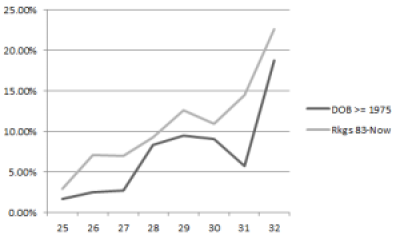You’ve probably heard about the steady aging of professional tennis. In both the men’s and women’s games, fewer teenagers than ever are winning important matches, and more and more thirty-somethings are remaining at the top of the game.
My favorite illustration: 25 years ago, the oldest man in the Australian Open draw was Johan Kriek, about two months short of his 31st birthday when the tournament began. This year, 24 men in the main draw are older.
A total of 33 men in the singles draw have reached their fourth decade, only the third time in tournament history that the number has exceeded 20. If lucky loser Stephane Robert replaces the injured Gilles Simon, we’ll have 34 thirty-somethings, tied with the all-time record, set in 2012.
Even without Simon’s withdrawal, we already have a record for average age in the men’s draw. That figure this year is 27 years and 126 days, 80 days more than the previous record, set last year. (Replacing Simon with Robert would add another 11 days to the average.) The new record also marks the seventh consecutive year that the average age of the men’s singles draw has increased.
While the age of the women’s draw isn’t quite record-setting, the rise of thirty-somethings in the women’s game has been even more rapid. Only 13 years ago, in 2001, Els Callens was the only woman over the age of 30 in the draw (she was a mere 156 days past her 30th birthday). This year, there are a record-high 15 players over the age of 30 in the women’s singles draw.
The 2012 Aussie Open field remains the oldest on record, at 24 years and 321 days. This year’s draw–at 24 years and 292 days–is close enough that, had 16-year-old Ana Konjuh lost her third-round qualifying match to Olga Savchuk, ten years her senior, we would be looking at a new record.
Long term trends and the folly of forecasting
By just about any metric you might devise, the game has gotten steadily older for about 25 years. As with any trend in the news, this one has led too many commentators–both casual and more academic–to claim that this is a permanent trend, or that “you’ll never see another teenage tennis champ.”
Protip: Never put your money on “never.”
What these arguments often fail to account for is that, for about twenty years after the inception of the pro game in the late 1960s, the sport–both men’s and women’s–consistently got younger. When the 2012 Wimbledon men’s draw broke that event’s record for average age, the record it was breaking was from 1968.
Sure, there are plenty of possible explanations for the steady age decline of the 1970s and 1980s, just as there are many for the current increase. And there are probably hard limits at either extreme that prevent the age of the game from swinging too far in either direction.
In any case, we’re not in the middle of an infinite rise in ages any more than we were amid an endless decline in 1985. Twenty years from now, the 2014 Aussie Open data points could be an meaningless step on this upward path or an important inflection point in another shift in the game. We’re unlikely to see a teenage Slam champ next year, or the year after that, but is it really possible to make a sensible case that, in six years, today’s 12-year-olds will be helpless against today’s 24-year-olds?
What we can be confident about is what has happened, and even without accounting for the return of Pat Rafter, this year’s Melbourne field represents yet another data point in the aging of elite-level tennis.
—
Detailed stats: Lots of great things are happening with the Match Charting Project. Several people have stepped forward and started contributing to the project already this year, and we’re up to 144 matches in the database. From Day One in Australia: Bencic vs Date-Krumm, Venus vs Makarova, and Errani vs Goerges. I hope you’ll join in the fun.

